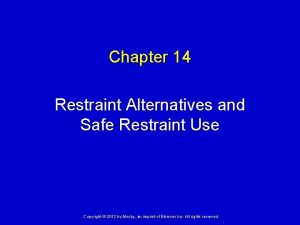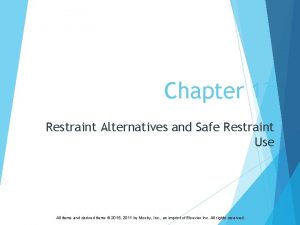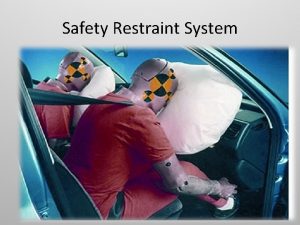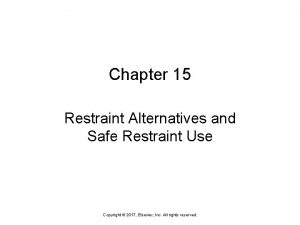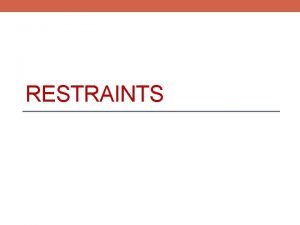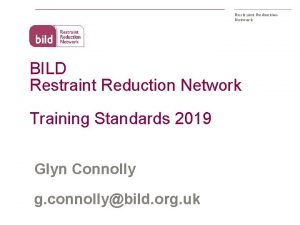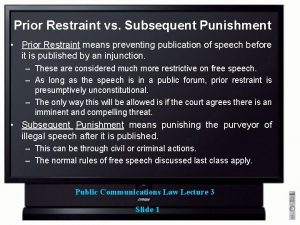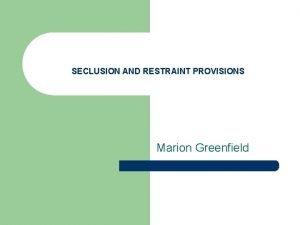MODULE 7 RESTRAINT SECLUSIONRS FOR NONNURSING DEFINITION RESTRAINT














- Slides: 14

MODULE 7 RESTRAINT & SECLUSION(R/S) FOR NON-NURSING

DEFINITION: RESTRAINT - Any manual method, physical or mechanical device, material or equipment that immobilizes or reduces the ability of a patient to move his/her arms, legs, body or head freely. If the patient can easily remove the device, material or equipment, it is not considered a restraint.

DEFINITION: SECLUSION ‐ The involuntary confinement of a patient in a room alone or in an area where the person is physically prevented from leaving. It may only be used for management of violent or self destructive behavior. Note: Seclusion does not include confinement on a locked unit or ward where the patient is with others.

WHEN CAN R/S BE USED? • Restraint and/or Seclusion may only be used if needed to improve the patient’s well being and when less restrictive interventions have been determined to be ineffective in protecting the patient or others from harm. Once the unsafe condition/ situation ends, the use of R/S will be discontinued.

RESTRAINT ARE 4 SIDE RAILS UP CONSIDERED A RESTRAINT? • Side rails are not considered a restraint when used to prevent the patient from falling out of bed when on a stretcher, recovering from anesthesia, sedated, experiencing involuntary movement, or on certain types of therapeutic beds • Side rails are considered a restraint when all four are in use to restrict the patient’s freedom to exit the bed unless the patient is able to easily lower the side rails.

RESTRAINT PHYSICAL HOLDING • Physical holding is not considered a restraint when holding for the purpose of conducting a routine physical examination or test. However, the patient has the right to refuse treatment. • Physical holding is considered a restraint if the patient is being held against their will. • Holding the patient down in order to administer a medication against the patient’s wishes is considered a restraint. • In certain emergency situations, with a physician order, some patients may be medicated against their will (example: the behavioral health setting)

RESTRAINT NON-VIOLENT OR NON-SELF DESTRUCTIVE RESTRAINT • Restraint used to limit mobility or temporarily immobilize an acute care patient for a reason specifically related to a medical or post‐surgical procedure ‐ applies to situations in which behavior changes are caused by medical conditions or symptoms, e. g. , confusion or agitation in which protective interventions may be necessary ‐ applies when restraints must be applied to directly support medical healing ‐ Example : a patient is attempting to dislodge a tube or line or is actively trying to get out of the bed and would compromise healing

RESTRAINT VIOLENT OR SELF-DESTRUCTIVE RESTRAINT • Restraint used only in an emergency or in a crisis situation if a patient’s behavior becomes violent or self‐destructive presenting an immediate, serious risk to his/her safety or that of others and non‐physical interventions are not effective - applies to clinical justification to protect self from injury to self or others because of an emotional or behavioral disorder where the behavior may be violent or aggressive NOTE: The use of R/S for violent/self-destructive behavior must be limited to the duration of the emergency safety situation regardless of the length of the order.

WHEN TO APPLY RESTRAINT NON-VIOLENT OR NON-SELF DESTRUCTIVE RESTRAINTS • Patient is pulling at lines, tubes or dressings • The confused patient is interfering with the provision of care • The patient is attempting an unsafe activity ‐ patient is thrashing around in bed or attempting to get out of bed in a way or under conditions where it might cause harm ‐ patient is exhibiting behaviors related to acute withdrawal syndrome • The patient’s diagnosis or condition is such that they may unpredictably and suddenly awaken and harm themselves. • One example is the intubated patient: ‐ When an intubated patient has a neurological condition that may cause them to unpredictably and suddenly awaken with a significant risk of self-extubation before staff could have an opportunity to intervene

WHEN TO APPLY RESTRAINT VIOLENT OR SELFDESTRUCTIVE RESTRAINTS • applies when the patient’s behavior is irrational, uncooperative, aggressive, and/or violent and are pose a danger to himself/herself or others and which behavior may also interfere with a medical or surgical procedure or medical healing. • These type of restraints require a Face-to-Face Assessment by either a physician or an RN that has attended completed a Faceto-Face Assessment class. competency.

ORDERS • R/S will be ordered by a physician who is a member of the medical staff. • • • As needed (prn) R/S orders will not be accepted. • The order will specify the method of R/S to be used. Indications will be documented in nursing or physician’s notes. • If the initial order is not obtained from the patient’s attending physician, consultation with the attending physician will occur as soon as possible. A “trial release” is not permitted. Temporary release while caring for the patient for feedling, range of motion and/or toileting is permitted and is not defined as a “trial release”. ‐ The attending physician is the physician who is responsible for the management and care of the patient.

GENERAL PROVISIONS • Indications: R/S will only be used for the protection of the patient, staff members or others, hospital property or to maintain provision of care. Such indications will be present and documented at the initiation of and throughout the episode of restraint. • Least Restrictive Means: R/S will not be used when less restrictive interventions would be effective. • Early Release: R/S will be discontinued by the RN or physician when the behavior or condition which was the basis for the order is resolved, regardless of the duration of the original order.

DISCONTINUING R/S • The use of R/S will be discontinued when there is adequate and appropriate clinical justification that would indicate that restraint or seclusion is no long necessary

P LEASE C OMPLETETHE P OST T EST A FTER R EVIEWING T HE M ODULE
 Restraint alternatives
Restraint alternatives Restraint alternatives and safe restraint use
Restraint alternatives and safe restraint use C device module module 1
C device module module 1 Formuö
Formuö Typiska novell drag
Typiska novell drag Tack för att ni lyssnade bild
Tack för att ni lyssnade bild Vad står k.r.å.k.a.n för
Vad står k.r.å.k.a.n för Shingelfrisyren
Shingelfrisyren En lathund för arbete med kontinuitetshantering
En lathund för arbete med kontinuitetshantering Adressändring ideell förening
Adressändring ideell förening Tidbok för yrkesförare
Tidbok för yrkesförare Sura för anatom
Sura för anatom Densitet vatten
Densitet vatten Datorkunskap för nybörjare
Datorkunskap för nybörjare Boverket ka
Boverket ka
